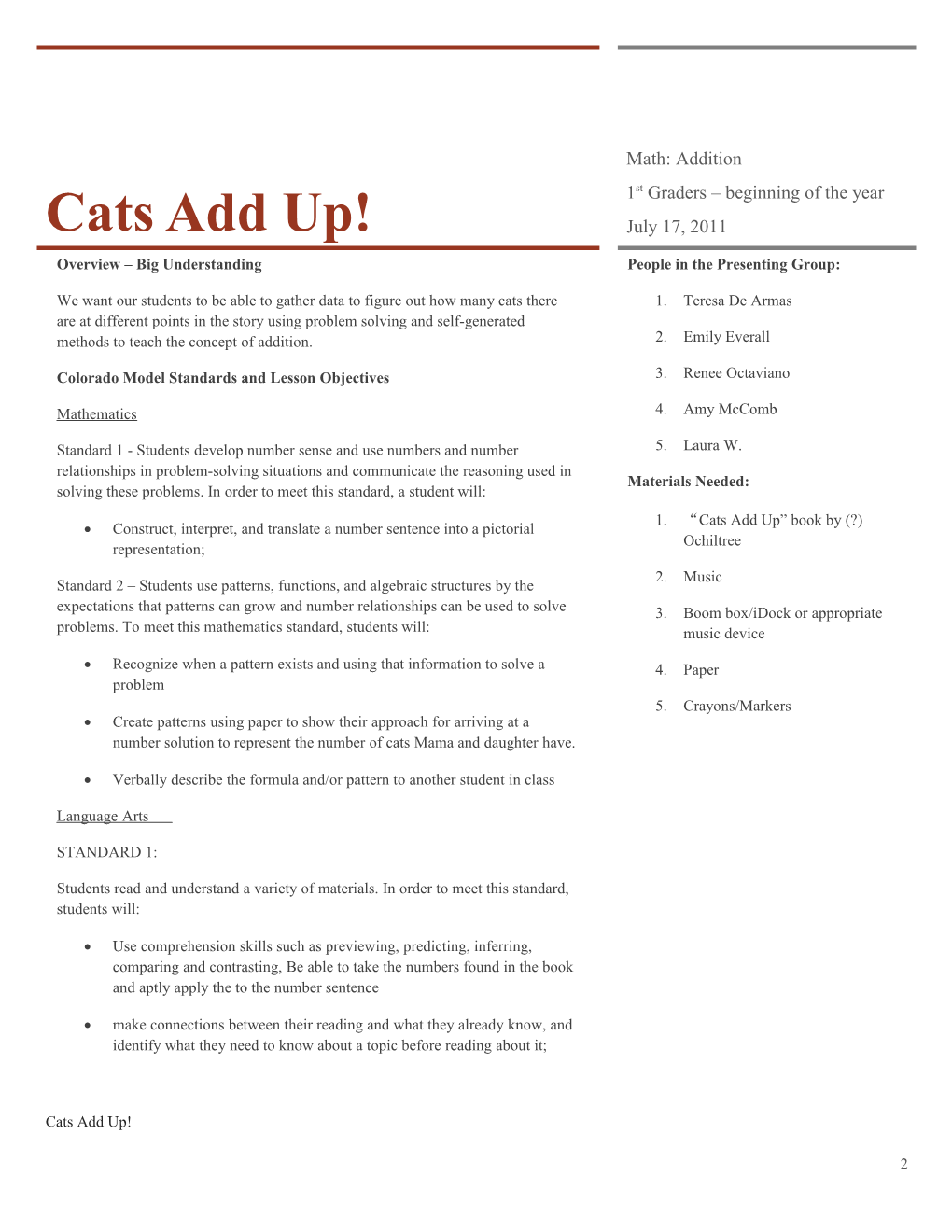Cats Add Up! / Math: Addition
1st Graders – beginning of the year
July 17, 2011
Overview – Big Understanding
We want our students to be able to gather data to figure out how many cats there are at different points in the story using problem solving and self-generated methods to teach the concept of addition.
Colorado Model Standards and Lesson Objectives
Mathematics
Standard 1 - Students develop number sense and use numbers and number relationships in problem-solving situations and communicate the reasoning used in solving these problems. In order to meet this standard, a student will:
· Construct, interpret, and translate a number sentence into a pictorial representation;
Standard 2 – Students use patterns, functions, and algebraic structures by the expectations that patterns can grow and number relationships can be used to solve problems. To meet this mathematics standard, students will:
· Recognize when a pattern exists and using that information to solve a problem
· Create patterns using paper to show their approach for arriving at a number solution to represent the number of cats Mama and daughter have.
· Verbally describe the formula and/or pattern to another student in class
Language Arts
STANDARD 1:
Students read and understand a variety of materials. In order to meet this standard, students will:
· Use comprehension skills such as previewing, predicting, inferring, comparing and contrasting, Be able to take the numbers found in the book and aptly apply the to the number sentence
· make connections between their reading and what they already know, and identify what they need to know about a topic before reading about it;
STANDARD 4:
Students apply thinking skills to their reading, writing, speaking, listening, and viewing. In order to meet this standard, students will
· use reading, writing, speaking, listening, and viewing to define and solve problems;
Engagement (Informal Pre-assessment/Before Learning):
1. Open up a discussion about cats
2. Ask Questions
a. How many of you have cats?
b. Is anyone here allergic to cats?
c. How many cats do you have?
d. For all of you who do have cats show me with your fingers held high how many cats you do have?
3. Show the cover of the book.
4. Ask for observations, predictions, and inferences about the book
Investigation (During Learning):
1. Explain to the children that we will be reading it twice. Once for listening and once for thinking.
2. Read the book “Cats Add Up” by Dianne Ochiltree
3. Discussion about the book:
a. How many cats did she start with? (ELL)
b. What was the greatest number of cats she had at one time?
c. What do you remember about the story?
d. How did they wind up with so many cats at the end?
4. Explain: Now we will be reading again and this time I will be keeping track of the cats on the board by writing a number sentences.
5. Reread the book and ask the class to help generate specific number sentences for each time the characters acquire more cats.
6. Instruct students to pick a number sentence that they will represent with a picture.
7. Take suggestions from the students for alternate ways they could represent the cats (introducing the basic idea of symbolism).
8. Once students have chosen a number sentence, they indicate by giving a thumbs-up, and are dismissed to their table.
9. Allow a students a few minutes to work on their drawings.
Explain and Clarify:
Lesson Closure:
1. Play Hand Up Pair Up
2. Give Directions - Students will stand up and walk to the sound of the music. When the music stops they will freeze and high five somebody close to them (may be one group of three). (One hand they are carrying their piece of paper) They will then share with the high fived partner the number sentence they chose and how they represented it.
3. Begin game with time allowed for discussion.
4. Turn the music back on and have the kids walk around with their papers. Call on a few groups very clearly.
Possible Extensions – Meeting the Needs of All Students
· Observing and explaining how a change in one quantity can produce a change in another (for example, the relationship between the number of cats and the numbers of feet, eyes, ears, tails)
· Additional discussion may include: how many people at your table have cats, how many in the class, how many cats do girls have, boys have, who has white cats? (etc. – classification)
· Reread again and highlight subtraction
· Bring in more locomotor opportunities with Hands Up Pair Up
· Make poster of number sentences and have kids organize their sheets accordingly. / People in the Presenting Group:
1. Teresa De Armas
2. Emily Everall
3. Renee Octaviano
4. Amy McComb
5. Laura W.
Materials Needed:
1. “Cats Add Up” book by (?) Ochiltree
2. Music
3. Boom box/iDock or appropriate music device
4. Paper
5. Crayons/Markers
Cats Add Up! / 2
Cats Add Up!
